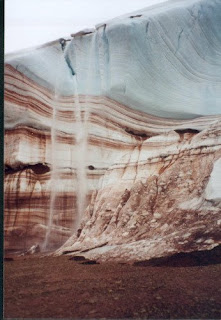HISTORY OF ICE CAPS.
Although the polar ice caps have been in existence for millions of years, scientists disagree over exactly how long they have survived in their present form. It is generally agreed that the polar cap north of the Arctic Circle, which covers the Arctic Ocean, has undergone contraction and expansion through some 26 different glaciations in just the past few million years. Parts of the Arctic have been covered by the polar ice cap for at least the last five million years, with estimates ranging up to 15 million. The Antarctic ice cap is more controversial; although many scientists believe extensive ice has existed there for 15 million years, others suggest that volcanic activity on the western half of the continent it covers causes the ice to decay, and the current south polar ice cap is therefore no more than about three million years old.
At least five times since the formation of the earth, because of changes in global climate, the polar ice has expanded north and south toward the equator and has stayed there for at least a million years. The earliest of these known ice ages was some two billion years ago, during the Huronian epoch of the Precambrian era. The most recent ice age began about 1.7 million years in the Pleistocene epoch. It was characterized by a number of fluctuations in North polar ice, some of which expanded over much of modern North America and Europe, covered up to half of the existing continents, and measured as much as 1.8 mi (3 km) deep in some places. These glacial expansions locked up even more water, dropping sea levels worldwide by more than 300 ft (100 m).Animal species that had adapted to cold wheather, like the mammoth, thrived in the polar conditions of the Pleistocene glaciations, and their ranges stretched south into what is now the southern United States.
The glaciers completed their retreat and settled in their present positions about 10–12,000 years ago. There have been other fluctuations in global temperatures on a smaller scale, however, that have sometimes been known popularly as ice ages. The 400 year period between the fourteenth and the eighteenth centuries is sometimes called the Little Ice Age. Contemporaries noted that the Baltic Sea froze over twice in the first decade of the 1300s. Temperatures in Europe fell enough to shorten the growing season, and the production of grain in Scandinavia dropped precipitously as a result. The Norse communities in Greenland could no longer be maintained and were abandoned by the end of the fifteenth century. Scientists argue that data indicate that we are currently in an interglacial period, and that North polar ice will again move south some time in the next 23,000 years.











.jpg)